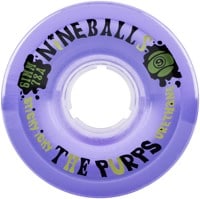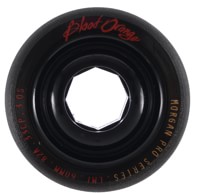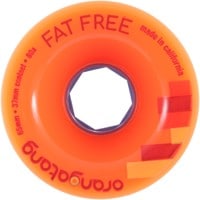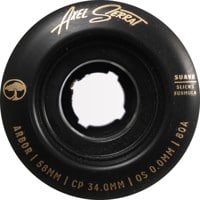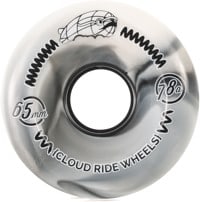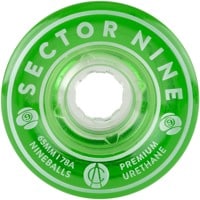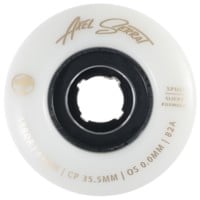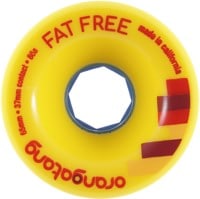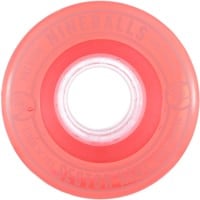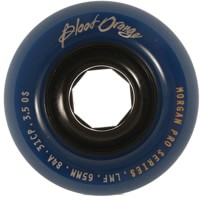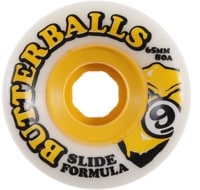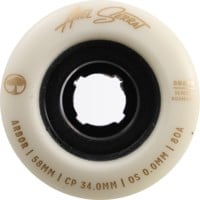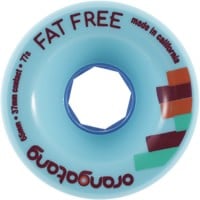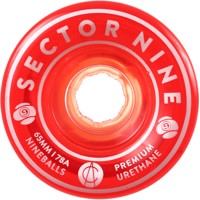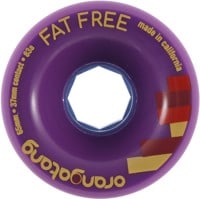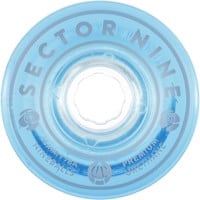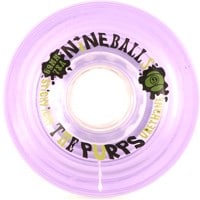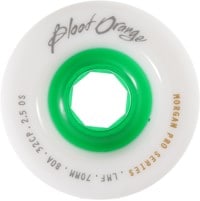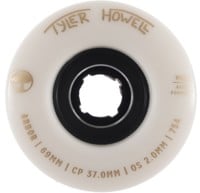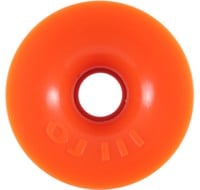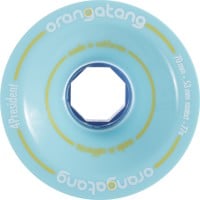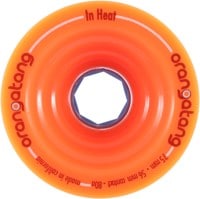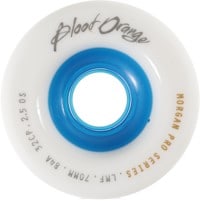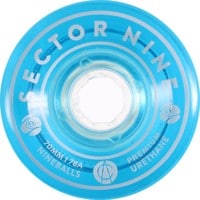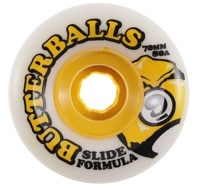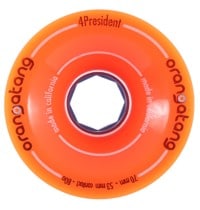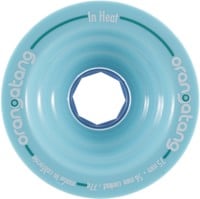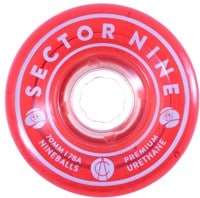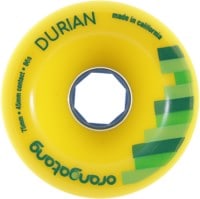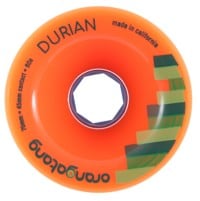Choosing Longboard Wheels
Dig into this guide to find the best longboard wheels for you. There's a huge variety of longboard wheels made for many different types of riding, so we're here to help you choose the right longboard wheel size, shape, harness for your setup.
Here’s what we’ll cover:
Longboard Wheel Size
LONGBOARD WHEEL DIAMETER
The first decision you need to make when choosing longboard wheels is what size you want. Most longboard wheels are between 64-80mm in diameter with 70mm being the most common size. The most important thing to consider is whether the wheels will fit on your setup without causing wheelbite.
TIP: A set of 65mm longboard wheels and a ¼'' riser pad will turn any park deck into a great city cruiser.
Small Wheel Diameter
Smaller wheels will fit on more setups and accelerate faster but have a slower top speed. If you install them on a park or cruiser deck, they also only require smaller riser pads, if any, keeping your deck lower to the ground providing more pop when you ollie.
Large Wheel Diameter
In general, larger wheels accelerate slower but have a higher top speed and will more easily roll over cracks and debris. If your deck has large cut outs then you should be able fit any size wheel. If your board does not have cut outs, you may need to add a ¼'' riser pad or more to accommodate wheels that are larger than 65mm.
LONGBOARD WHEEL CONTACT PATCH
The contact patch is the surface of the wheel which rolls on the ground. A wider contact patch gives a wheel more grip and is generally preferred for downhill while a narrower contact patch gives the wheel less grip and is generally preferred for freeride. While sliding, a wider contact patch will slow you down quicker and give you more control, but will be harder to initiate and have a more abrupt transition from grip to slip.
Wide Wheels
A wider contact patch gives a wheel more grip and is generally preferred for downhill riding. While sliding, a wider contact patch will slow you down quicker and give you more control, but will be harder to initiate and have a more abrupt transition from grip to slip.
Narrow Wheels
A narrower contact patch gives the wheel less grip and is generally preferred for freeride. Narrower wheels will generally initiate slides more easily, and retain speed throughout the slide.
Stone Ground Wheels
Stone ground contact patches are very popular for freeride wheels and are highly recommended for beginners who want to learn how to slide. When brand new wheels come out of their molds, they have a shiny skin on their surface which is very grippy. It usually takes multiple slides to wear the skin off before a wheel slides smoothly, so many manufacturers stone grind the contact patches of their round lipped freeride wheels so that they slide great right out of the package.
Longboard Wheel Shape
Square Lip Longboard Wheels
Sharp or thick square edges make wheels more grippy. Square lip wheels are typically preferred for downhill skating because they allow you to hold your grip through fast corners. They can still be used to slide, but are less forgiving than round lip wheels.
Lip style is less important for cruising and carving, but square lip wheels are a good option because they allow you to carve deeper and corner tighter without worrying about losing traction.
Round Lip Longboard Wheels
Rounded edges allow wheels to break traction more easily and offer smoother transitions into slides, so we recommend them for freeriding and stand up sliding. They are also great options for cruiser setups because they are typically lighter and allow you to powerslide more easily when needed
Longboard Wheel Hardness (Durometer)
Hardness of longboard wheels is measured by Durometer ratings on the Shore A scale. Most longboard wheels have a durometer from 75-88a, making them very soft in comparison to typical skateboard wheels which usually range from 95-101a. In general, softer longboard wheels have more grip but roll slower while higher durometer longboard wheels have less grip but roll faster. The most popular durometers for nearly all types of longboarding are 78a and 80a because they have a happy medium of grip, roll speed, and slide-ability.
Softer Longboard Wheels
Softer wheels (75-80a) will typically slow you down faster, and have a tendency to smear across the surface of the road. This typically makes them less durable, but much easier to control at faster speeds. Softer wheels commonly leave thick thane lines as the wheels urethane is transferred from the wheel to the road.
Harder Longboard Wheels
Durometer also affects slide characteristics. Harder wheels (83-88a) will typically slow you down less and have a tendency to glide across the surface of the road. This makes them more durable and a great choice for riding at slower speeds.
URETHANE FORMULAS
Durometer is a good general guide to use for narrowing down your longboard wheel choices, but not all 78a wheels preform the same. A wheel's urethane formula dictates just as much about the way the wheel performs.
Every urethane formula is different and has varying degrees of grip, durability, and slide-ability. The best way to learn the characteristics of a urethane formula is to try several types and get a feel for your own preferences. Luckily, many companies have categorized their different formulas as freeride or downhill. In general, freeride formulas will slide easier and faster while providing less grip and durability than downhill formulas.
Longboard Wheel Cores
There are three categories of core placement that are common among longboard wheels: centerset, offset, and sideset. Each style will give you slightly different performance and slide characteristics.
CENTERSET LONGBOARD WHEELS
Centerset wheels have cores that are placed directly in the center of the wheel, equidistant to the outer edge of each lip. This core placement gives the most amount of grip because it creates a very large inner lip. However center set wheels are still a great option for sliding because they can also be flipped inside out to promote even wear and a longer lifespan.
SIDESET LONGBOARD WHEELS
Sideset wheels have cores that are directly aligned with the inner lip of the wheel. This core placement has the least amount of grip because it allows little to no inner lip. Sideset wheels make it easy to initiate slides with little required force, but their lack of grip also makes their slides harder to control. A sideset core also causes the inner lip to wear much faster than the outer lip which can result in severe coning. Despite their drawbacks, sideset wheels are still very fun to ride, and a great option for beginners who are learning to break traction on their longboards.
OFFSET LONGBOARD WHEELS
Offset wheels have cores that are placed somewhere between centerset and sideset. By blending the characteristics, offset wheels give the rider the best of both worlds. Most downhill wheels and many freeride wheels are offset because they give you a more forgiving slide initiation and hookup while still providing ample grip and control in the slide.
If you're looking for extra grip, you can flip your offset wheels inside out. This can give you the most amount of grip, but once the wheels start sliding, they can be harder to control and give a more abrupt hookup.
CORE SIZE & SHAPE
The size, shape, and composition of the core of a wheel also plays a large role in the way it performs.
Adding a larger diameter core will make will make a wheel roll faster, which is a great benefit for transportation, freeride, and downhill. Wider cores help support the urethane better which makes the wheel more resilient to ovaling and promotes even wear. Using a harder material in a core will also improve roll speed and help prevent deformation of the urethane during slides to promote even wear. However, these qualities can also make the wheel slide faster. Slowing down quickly is a must for downhill racing, so manufacturers must be very careful about the size and composition of the cores they use.
Keep Learning
Still Have Questions?
We’re here to help. You can call, email, chat or IM during business hours seven days a week. Our customer service staff skates…a lot. They know their stuff and are happy to help you with all things skate.
